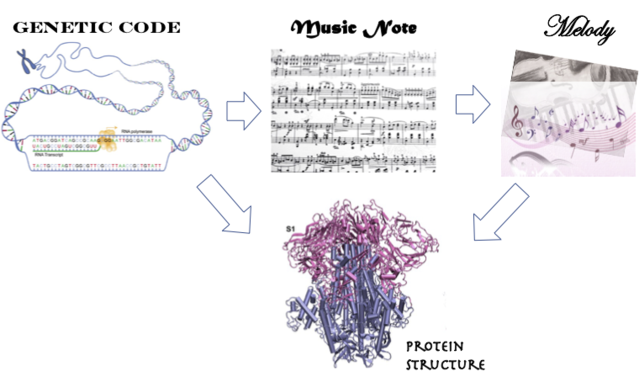Genetics
Turning Data Into Music May Help Scientists Study Nature
Can music tell us something about our genes?
Posted May 16, 2022 Reviewed by Devon Frye
Key points
- New studies are turning scientific data—such as sequenced DNA or protein information—into musical notes.
- This transformation can provide a new framework for understanding how complexity arises from sequenced patterns of DNA or amino acids.
- Turning scientific data into music may support new computational tools, including artificial intelligence for analyzing genomes.
- Music can enhance science pedagogy in ways that support creativity and STEAM outreach in the classroom and laboratory.
Louis Armstrong said that “music is life itself”—and indeed, music naturally resonates with the full spectrum of human emotions from joy to sadness.
The history of humanity is deeply entrenched in musical traditions that mark important occasions across all known cultures. Even newborns can respond to music, and like language, our brain appears wired for synthesizing and processing music. The ability to hear pitch, comprehend, and, if trained, compose a universal melody depends on the evolved properties of neurons in many of the same brain areas that are used for speech, sound, and other important complex functions such as navigation and abstraction. Yet, intuitively, music touches us and holds a place of context and meaning.
Until recently, music has remained largely separate from science, despite the fact that it is used as a powerful communication tool by other major industries. But an innovative line of work is beginning to change that through the development of methods for transforming scientific data into musical notes. Among these is the eerie sound of the SARS-CoV2 viral protein turned into a musical composition.
Biological Sequences and Musical Notes Share Analogies
Ongoing efforts to turn science into audible sound involve the conversion of sequenced DNA or protein information into musical notes. Since all living cells are made of inherited sequences of DNA, which code for proteins that drive the function of life, data-to-music transformation aims to provide a new framework for understanding how complexity arises from sequenced patterns. This kind of work may also help solve some genetic puzzles, such as neurodegeneration through Huntington’s Disease, which appears to arise because of a specific change in the coding sequence of a gene.
It is interesting to think that genetic sequences and musical notes share traceable analogies. For example, notes are typically assembled through recurring patterns, and like genes and proteins, these patterns can give rise to higher-order structures and complex shapes and forms. A new generation of algorithms and tools is being developed based on this analogy and is using music to explore how an inherited sequence codes for a functional structure in a molecule, and to identify regions within the structure for drug design. Similar research is using music theory to investigate how changes in the structure of the amyloid protein can contribute to Alzheimer’s disease using a model of natural frequency to study the molecule’s movement.

Music May Give Science a New Way to Think about Data
In the immediate, these creative endeavors may serve very defined goals—like understanding relationships between sequences and structures in areas that are important for human disease. Beyond that, turning science data into music may support new computational tools, including artificial intelligence, that can be deployed to predict how any gene or protein sequence may operate. This approach may give scientists a new way to think about their data and thus inspire new hypotheses.
Finally, because music is truly a universal language, transforming science into music may appeal to a broader and more neurodiverse spectrum of individuals, not to mention support learning for the visually impaired. It would be exciting to think that we can use music to expand science pedagogy in ways that support creativity and STEAM outreach, appealing to artistic minds that may also be inspired by the challenge of science.
References
Nicole W, Fanxi L, Chaoxin W, Hui Z, Peng Z, Yu Z. Protein music of enhanced musicality by music style guided exploration of diverse amino acid properties. Heliyon 2021, 7(9):e07933.
Paul T, Vainio S, Roning J. Clustering and classification of virus sequence through music communication protocol and wavelet transform. Genomics 2021, 113:778-784.
Acan S, Acan N. Music notes to amino acid sequence: A STEAM approach to study protein structure. Biochem Mol Biol Educ 2019, 47(6):669-671.
Yu C, Qin Z, Martin-Martinez F, Buehler M. A Self-Consistent Sonification Method to Translate Amino Acid Sequences into Musical Compositions and Application in Protein Design Using Artificial Intelligence. ACS Nano 2019, 13(7):7471-7482.


